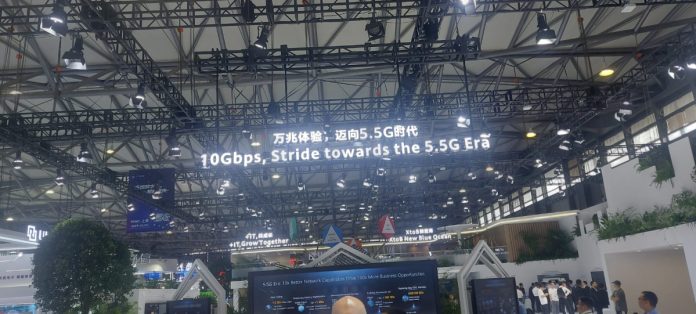DM Monitoring
ISLAMABAD: The three-day Mobile World Congress (MWC), commenced from 28-30 June, came to a dramatic close in Shanghai, culminating in the revelation that Huawei intends to introduce a comprehensive suite of commercial 5.5G network equipment in 2024.
The congress kicked with Huawei’s vibrant product and solutions exhibition at booths E10 and E50 in Hall N1 of the Shanghai New International Expo Centre (SNIEC), said a press release.
Joined by a global assembly of operators, industry leaders, and thinkers, the event delved into a plethora of subjects like accelerating 5G growth, transitioning towards the 5.5G epoch, and intelligent digital transformation. With its potential to revolutionize areas such as human connectivity, Internet of Things (IoT), and Internet of Vehicles (IoV), 5.5G is expected to offer novel business value, powering numerous industries on their journey towards an intelligent world.
The conference’s inaugural day witnessed a powerful keynote address from Sabrina Meng, Huawei’s Rotating Chairwoman and Chief Financial Officer.
She asserted the transformative influence of 5G across various sectors and households worldwide, altering work and lifestyle patterns while generating remarkable economic, industrial, and social value. In her address titled “Embracing 5G transformation,” Meng said “Having been in commercial use globally for the past four years, 5G is driving new value creation, with 5.5G representing the future trajectory.” She emphasized that the evolution of science and technology towards more substantial, intricate systems necessitates tailoring technology to specific scenarios and undertaking systems engineering, all to ensure 5G’s ongoing success.
She delineated how 5G is creating value across three separate dimensions and said, “Science and technology are moving towards large, complex systems. This requires matching technology to specific scenarios and performing systems engineering, in order to pave the way for 5G’s ongoing success.”
5G is creating value along three different fronts, she said adding science fiction can only sketch the future but science and technology can turn imagination into reality.
“For consumers, 5G, cloud, and AI have set off a chain reaction, creating an environment where all buyers can also be sellers. For industries, 5G has become a new driver of productivity. There’s greater alignment than ever between technology suppliers, their partners, and customers and 5G can provide the most value. Strategic patience, in-depth understanding of industrial scenarios, and ongoing improvements to ROI have given 5G a foothold in industrial applications.
Moving ahead, 5G will give rise to new devices and applications that deliver a more immersive experience, like 5G New Calling and naked-eye 3D. 5G is also ushering in a new era of super-connectivity between things, bringing new strength to IoT networks and driving new forms of productivity.”
She said, “5.5G is the next step forward for 5G. 5.5G will feature 10-gigabit downlink speeds, gigabit uplink speeds, the ability to support 100 billion connections, and native AI. It will not only connect people better – it will also create incredible new business opportunities with more targeted support for industrial needs in domains like IoT, sensing, and advanced manufacturing.”
“The ladder to success isn’t built on ongoing progress with a single technology,” Meng noted adding, “It’s built on matching technology to specific scenarios and real-world needs. And systems engineering is key to taking the next step up.
The commercial deployment of 5G has created a growing appetite for more groundbreaking, leapfrog innovation. So what will take 5G to the next level, and how will it provide greater value in different vertical markets?”
” This will require finding the right technology for different scenarios and performing more comprehensive systems engineering. This will also require diving deeper into industrial scenarios, truly understanding customers’ pain points, and adopting a more holistic systems engineering mindset. The industry needs to work more closely together both up and down the value chain – with peers and partners, customers and developers – on solution modeling and optimization, as well as tools and methodologies. The industry also needs to pave the way for ongoing success throughout the entire product lifecycle, from R&D and procurement, to supply and marketing,”she opined.
The digital infrastructure of the future intelligent world will be deeply integrated into every aspect of people’s lives, industry, and society, she pointed out, adding, “It won’t be based on advancements in individual technologies, but rather on incredibly massive, complex systems – the convergence of multiple elements. It’s going to require systems-level thinking and design. When watching a chess game, you can see the big picture. But when you’re playing chess, you focus on the details. Likewise, systematic capabilities to integrate technology and transform management are critical for the future success of 5G.”
On the conference’s second day, Huawei’s Director and President of ICT Products and Solutions, Yang Chaobin, announced the impending launch of a comprehensive set of commercial 5.5G network equipment in 2024.
He indicated that this launch would symbolize the onset of the 5.5G era for the information communication technology industry.
“The rapid progress of 5G deployment over the past four years has already started to yield significant financial gains,” said Yang, noting that over 1.2 billion users are served by more than 260 commercial 5G networks globally.
As the services and content continue to evolve, technologies such as glasses-free 3D have emerged, offering unprecedented immersive experiences for users. Nevertheless, these innovative services still demand enhanced 5.5G network capabilities. There is broad industry agreement that 5.5G will serve as a pivotal milestone in the evolution of 5G, and that this point is rapidly approaching.
Huawei has proposed the concept of a “5.5G Era,” comprising an end-to-end solution integrating evolved technologies including 5.5G, F5.5G, and Net5.5G. The intention behind this solution is to safeguard operators’ previous investment in 5G while simultaneously improving network performance by tenfold. The 5.5G Era is anticipated to feature peak downlink speeds of 10 gigabits and peak uplink speeds of one gigabit to cater to increasingly diverse service requirements.
In anticipation of the commercial deployment of 5.5G, Yang said, “Huawei is excited to work with all industry players on this new journey towards the 5.5G era.”
While the industry is only in the earliest stages of developing a vision for 6G, many have already set their sights on 5.5G as the marker for future progress. The 10-fold enhancement in network capabilities in the 5.5G Era is anticipated to enable various industries to unlock the power of digital technology.






